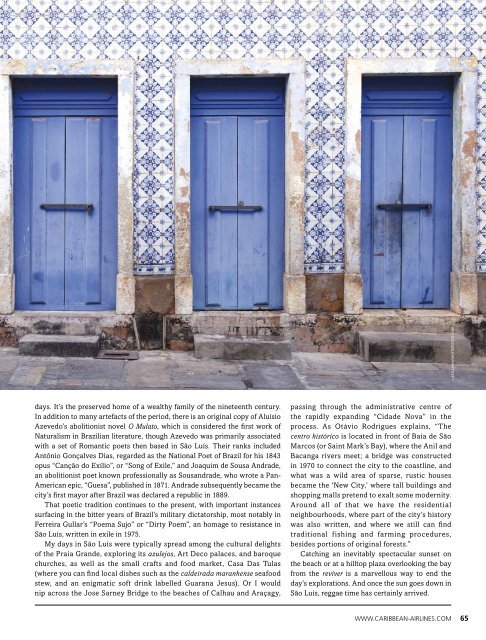Create successful ePaper yourself
Turn your PDF publications into a flip-book with our unique Google optimized e-Paper software.
lazyllama/shutterstock.com<br />
days. It’s the preserved home of a wealthy family of the nineteenth century.<br />
In addition to many artefacts of the period, there is an original copy of Aluísio<br />
Azevedo’s abolitionist novel O Mulato, which is considered the first work of<br />
Naturalism in Brazilian literature, though Azevedo was primarily associated<br />
with a set of Romantic poets then based in São Luís. Their ranks included<br />
Antônio Gonçalves Dias, regarded as the National Poet of Brazil for his 1843<br />
opus “Canção do Exílio”, or “Song of Exile,” and Joaquim de Sousa Andrade,<br />
an abolitionist poet known professionally as Sousandrade, who wrote a Pan-<br />
American epic, “Guesa”, published in 1871. Andrade subsequently became the<br />
city’s first mayor after Brazil was declared a republic in 1889.<br />
That poetic tradition continues to the present, with important instances<br />
surfacing in the bitter years of Brazil’s military dictatorship, most notably in<br />
Ferreira Gullar’s “Poema Sujo” or “Dirty Poem”, an homage to resistance in<br />
São Luís, written in exile in 1975.<br />
My days in São Luís were typically spread among the cultural delights<br />
of the Praia Grande, exploring its azulejos, Art Deco palaces, and baroque<br />
churches, as well as the small crafts and food market, Casa Das Tulas<br />
(where you can find local dishes such as the caldeirada maranhense seafood<br />
stew, and an enigmatic soft drink labelled Guarana Jesus). Or I would<br />
nip across the Jose Sarney Bridge to the beaches of Calhau and Araçagy,<br />
passing through the administrative centre of<br />
the rapidly expanding “Cidade Nova” in the<br />
process. As Otávio Rodrigues explains, “The<br />
centro histórico is located in front of Baía de São<br />
Marcos (or Saint Mark’s Bay), where the Anil and<br />
Bacanga rivers meet; a bridge was constructed<br />
in 1970 to connect the city to the coastline, and<br />
what was a wild area of sparse, rustic houses<br />
became the ‘New City,’ where tall buildings and<br />
shopping malls pretend to exalt some modernity.<br />
Around all of that we have the residential<br />
neighbourhoods, where part of the city’s history<br />
was also written, and where we still can find<br />
traditional fishing and farming procedures,<br />
besides portions of original forests.”<br />
Catching an inevitably spectacular sunset on<br />
the beach or at a hilltop plaza overlooking the bay<br />
from the reviver is a marvellous way to end the<br />
day’s explorations. And once the sun goes down in<br />
São Luís, reggae time has certainly arrived.<br />
WWW.CARIBBEAN-AIRLINES.COM 65


















